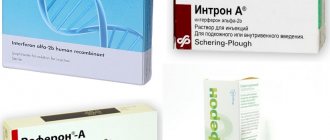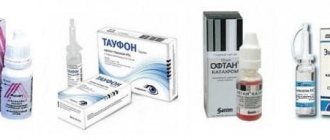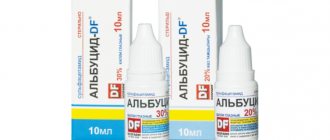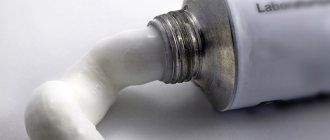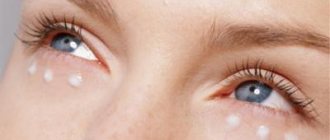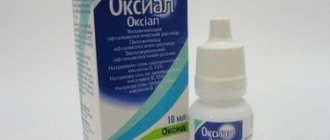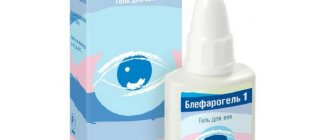Doctors recommend Chlorhexidine solution for washing the eyes to prevent and treat inflammatory processes of an infectious and bacterial nature. A strong antiseptic effect quickly eliminates the symptoms of ophthalmic diseases. The use of the medicinal solution has no age restrictions and rarely causes side effects if the dosage and concentration are strictly observed. However, in case of serious pathologies of the visual organs, it is recommended to consult an ophthalmologist before use.
Composition and action
The drug solution is applicable not only to humans, but is also used in veterinary medicine. Chlorhexidine effectively treats eye diseases in dogs and cats. Animals' eyes should be treated if an inflammatory process occurs with the release of pus or mucus.
Pharmacies usually sell a 0.05% solution, which can be instilled into mucous membranes without additional dilution. The liquid, colorless or with a slight yellow tint, without a characteristic odor, consists of the active substance chlorhexidine digluconate and distilled water. The optimal ratio is 1 to 2. The remedy has the following positive effect on the human visual organs:
- antiseptic;
- disinfectant;
- antibacterial.
Preventing conjunctivitis through irrigation and other measures
In some cases, rinsing the visual organs with saline solution can be used not as a therapeutic procedure, but to prevent conjunctivitis. It is advisable to rinse your eyes in the following cases:
- if you have been in contact with a person who has conjunctivitis;
- if you suffer from ARVI or infectious diseases of the nasopharynx (often the virus “rises” from the respiratory tract and can affect the eyes);
- if you have to spend a lot of time in conditions of dust or increased air pollution.
The saline solution washes away pathogens from the surface of the eyeball, prevents the development of infection, and has an antiseptic and moisturizing effect.
In addition to washing the eyes, there are a number of other effective measures to prevent inflammatory eye disease, primarily following the rules of personal hygiene:
- You need to wash your hands regularly and give up the habit of touching your face or rubbing your eyes with your hands.
- Each family member and each child in kindergarten should have their own towel and personal set of bed linen. The risk of infection through textiles increases when someone in your immediate environment suffers from conjunctivitis.
- You can’t take someone else’s cosmetics and let other people use yours.
- It is not recommended to visit large shopping centers and other public gatherings during periods of exacerbation of seasonal diseases.
- For allergy sufferers, it is advisable to exclude or minimize contact with the irritant.
- A child or adult who is ill with infectious conjunctivitis should remain at home until complete recovery in order to prevent infecting classmates, colleagues and everyone around them.
- To prevent conjunctivitis in newborns, a pregnant woman needs to have all possible genital infections diagnosed and treated before the baby is born (optimally before pregnancy).
Indications for use
The product will help stop the spread of bacterial infection.
Ophthalmologists recommend rinsing your eyes with Chlorhexidine or dripping the solution onto the mucous membrane in the following conditions:
- conjunctivitis;
- iritis and choroiditis;
- blepharitis;
- redness and swelling of the eyelids;
- swelling of the vascular network;
- keratitis;
- formation of purulent discharge;
- burning and itching in the eyeball;
- foreign body sensation;
- acute pain syndrome.
Instructions for use
Getting the product inside the eye can cause a burn to the mucous membrane.
When treating the eyes, a diluted solution of the drug is used, while children are recommended to use a concentration 2 times less than for adults. Pharmacies sell liquids containing 0.02% or 0.05%. When applying compresses, the following instructions for use are recommended:
- The medicinal solution is heated in the palms to room temperature.
- Eyes close tightly.
- Careful movements are made with a damp cotton pad from the outer corner to the lacrimal canal. It is not recommended to get liquid on mucous membranes.
- The optimal number of repetitions is 5-6 times a day. The eyes of a newborn can be wiped 2-3 times until the negative symptoms disappear.
If pure Chlorhexidine gets into the eyes, it will not cause pathological changes and will not damage the retina. It is enough to treat the mucous membrane with cool water from a kettle. It is not recommended to use flow-through, especially when providing care to newborns, to avoid infection.
The child is recommended to drip the solution into the corner of the eye. The optimal dosage is 1-2 drops. It is recommended to repeat the procedure up to 3 times a day, depending on the symptoms of the disease. You can instill it using a syringe, after removing the needle. After this, it is recommended to close the eye and lightly massage the eyelid so that the liquid is evenly distributed over the mucous membrane. Strong pressure is contraindicated. It is important to pre-treat your hands with disinfectant. However, soap or shower gel are not suitable; the optimal solution is alcohol.
How to clean your eyes
Cats are clean animals, but some breeds have an increased risk of conjunctivitis and dacryocystitis. Such representatives need to practice proper eye hygiene and regularly wipe their eyelids to prevent infection. In addition to infection, the causes of discharge from the eyes can also be allergic conditions, foreign bodies and diseases of the internal organs.
To clean your cat's eyes, veterinarians use a variety of disinfectants, including chlorhexidine. Antiseptics are used only for prevention or for treatment in combination with other antiviral, antibacterial and regenerating medicinal substances.
Pharmacy products
Among the antiseptics prepared in pharmacies, the following eye rinsing solutions are used:
- 0.01% chlorhexidine;
- 0.02% furatsilin;
- 0.9% sodium chloride;
- potassium permanganate diluted 1:5000;
- 2.5% boric acid.
It is not always possible to find a liquid with the required concentration of chlorhexidine or order its preparation at a pharmacy. In this case, you can prepare an antiseptic yourself by adding 16 ml of an isotonic solution of sodium chloride or distilled water to 4 ml of a 0.5% solution. Ready-made combination forms are also sold, such as Diamond Eyes, Clear Eyes and AiryPlus, which contain chlorhexidine.
Home Remedies
At home, herbal decoctions are suitable for washing or wiping the eyelids:
- chamomile;
- linden color;
- pharmaceutical elderberry.
To prepare them, you need 1-2 tsp per 1 glass of water. dry raw materials. The prepared solutions must be carefully filtered to avoid contamination and cooled to room temperature. You can also wash your sore eyes with brewed tea that has been left for 24 hours.
All information posted on the site is provided in accordance with the User Agreement and is not a direct instruction to action. We strongly recommend that before using any product, you must obtain a face-to-face consultation at an accredited veterinary clinic.
Are there any restrictions?
People prone to allergic reactions are advised to discuss the use of the drug with a doctor.
Despite the effectiveness of the antiseptic, it is not recommended for use by allergy sufferers due to possible individual intolerance to the components of the composition. Young children under 6 years of age should carefully calculate the dosage and use the lowest concentration so as not to cause a burn to the retina, which can impair vision. Additionally, rinsing your mouth and nose with the product is contraindicated. Pregnant women, due to hormonal changes, are advised to consult a doctor before use.
Compatibility with other drugs
The simultaneous use of Chlorhexidine and products containing iodine is contraindicated, as it can lead to dermatitis. The drug is incompatible with soap, shampoo and anionic antiseptics. It is recommended to check the list of medications with your therapist. In this case, ethanol can increase the effectiveness of the drug. Contact of Chlohexidine with carbonates, phosphates and sulfates should be avoided, as a precipitate will form and the product will become unsuitable for use.
What else is important to know
Typically, Chlorhexidine solution combines well with other medications. But in some cases caution should be exercised.
- The substance does not combine with soap, since soap is alkali, and Chlorhexidine contains chlorine. Before carrying out the necessary manipulations, you should definitely wash your hands with soap, but then you need to rinse them well under running water and wipe them thoroughly dry. If Chlorhexidine solution is used to disinfect hands, then you should no longer wash them with soap.
- The drug interacts with such a popular home antiseptic as iodine. The simultaneous use of two medicines may cause skin dermatitis.
- When combined with ethyl alcohol, the therapeutic effect of Chlorhexidine is enhanced. For this reason, predominantly an alcohol solution of the drug is available in pharmacies. But for the same reason, it is not recommended for use in pediatrics and for the treatment of women during the period of bearing and feeding a child.
An opened bottle or container with a solution prepared independently is stored in the refrigerator for no more than one week. Then the remaining product should be disposed of and a new portion should be prepared. When sealed at a temperature not exceeding 25 degrees Celsius, it can be stored for up to three years without losing its properties.
An analogue of Chlorhexidine solution for the eyes are Miramistin or Okomistin drops.
Summary: Chlorhexidine is a relatively new broad-spectrum antiseptic drug. It is used as a disinfectant for treating purulent wounds, skin and mucous membranes, disinfecting hands and medical instruments. Since the substance contains chlorine, it is not recommended for use in ophthalmology: Chlorhexidine can cause burns to the cornea. But if you dilute the drug with water to a weak concentration, you can wash your eyes with it for purulent conjunctivitis and other infections caused by the introduction of bacteria, some fungi and viruses. The medicine is available in pharmacies without a doctor's prescription. But this does not mean that it can be used uncontrolled; consultation with an ophthalmologist before starting a course of treatment is necessary, especially if we are talking about children under 12 years old, pregnant or lactating.
Consequences of overdose
If you drop pure or slightly diluted Chlorhexidine into the mucous membranes of the organ of vision, a chemical burn of the retina may occur. Characteristic symptoms include itching, burning, pain and increased lacrimation. You should immediately rinse your eyes and consult an ophthalmologist if symptoms do not go away within 1-2 hours. The dangerous consequences of a burn are deterioration of visual abilities and damage to the sclera, requiring medical treatment. In case of overdose, wiping your eyes with your hands or a towel is prohibited, as this can further damage the cornea and cause infection.
What kind of drug is Chlorhexidine?
This drug belongs to the group of antiseptic drugs. Chlorhexidine is classified as a drug used as a topical antiseptic. That is, it is used to treat the surfaces of the skin and mucous membranes. Chlorhexidine is widely used as a bacteriostatic and disinfectant.
Due to its composition, Chlorhexidine has a highly effective effect on gram-positive and gram-negative flora. A huge advantage of Chlorhexidine is its high efficiency in an environment where blood masses and exudate are present.
It is also important that Chlorhexidine acts on the integument and mucous membranes for a long time after application to them. In addition, Chlorhexidine solution can inhibit the growth and reproduction processes of microorganisms.


